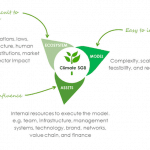Financial Inclusion Forum: The Technology Revolution
The Financial Inclusion Forum’s flagship event in 2016 was hosted during Financial Inclusion Week. The gathering, organised with the European Bank for Reconstruction and Development (EBRD), provided an opportunity to reflect on the past, present and future of financial inclusion. If you missed the event, you can watch the highlights here.
Technology was a recurring theme during the discussion, as we were reminded that more than 4.5 billion people own phones and there are over 130 active mobile money deployments across 90 countries. There is clearly a technology revolution taking place, currently in a client-centric phase. The EBRD set the tone by announcing participation in the Better Than Cash Alliance to accelerate the transition to digital payments and drive inclusive growth.
Nathaniel Young, EBRD’s principal economist, provided a preview of the EBRD Transition Report that confirms a positive correlation between access to finance and economic development. It also introduces the “Dissimilarity Index,” which indicates that demographic factors such as gender and age are determinants of financial inclusion. Barbara Rambousek, associate director of economic inclusion at the EBRD, added to this by providing insights on how structural barriers, including availability of childcare, land rights and inheritance laws, can hold back women from having comparable access to finance. The message was clear – gender is not a zero sum game and providing more opportunities for women increases overall access to finance.
With Yasmina McCarty, head of mobile for development at the GSMA, as moderator and Max Robinson, chief operating officer from VisionFund International, on the panel, a debate was raised around reaching communities most is need. This goal remains a costly endeavour and one requiring both continued philanthropic capital and more effective regulation. Maria Largey, director and head of financial institutions at the CDC, underscored that while progress hasn’t been linear, the increased focus on providing clients with a broader range of affordable, accessible and appropriate products is promising.
The recent Financial Inclusion Banana Skins report, which continues to provide a pulse for the sector, was presented by David Lascelles, its author, and the conversation was steered by Andrew Hilton, director of the CSFI, with Brad van Leeuwen, chief partnerships officer at dopay, and Vaughan Lindsay, director at Leapfrog Labs. While a risk survey may seem an unusual starting point for discussion, “strategy” was identified as the top risk in 2016 with key insights for companies on the implications of disruptors in financial inclusion.
Fintech is an enabler – it can decrease costs, providing new entrants with a competitive edge over incumbents who have legacy systems – but there is a risk of new technology looking for problems to solve rather than creating technology to address identified obstacles. Companies that are able to understand client behaviour and marry fintech with a high-touch, client-centric model are the ones likely to succeed in truly expanding access to finance.
We are grateful to the EBRD for hosting the event and to Brands2Life for public relations support. Thank you, also, to our distribution partners Business Fights Poverty and Innovate Finance.
Our next event is on Jan. 19, 2017, “Digital Financial Services: Are we reaching its full potential?” featuring Graham Wright from MicroSave and Anant Nautikal from GSMA.
Eugene Amusin, chairman of the Financial Inclusion Forum, is a senior vice president in Citi Microfinance.
This post originally appeared on Business Fights Poverty’s website and is reprinted here with permission.
- Categories
- Uncategorized



